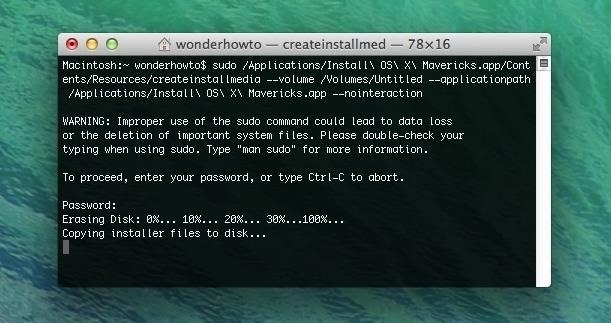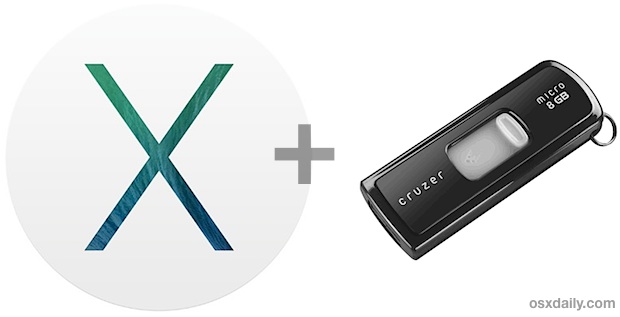
I can't create a bootable OSX Mavericks Install USB Drive. Ask Question Asked 7 years, 9 months ago. Active 4 years, 2 months ago. Viewed 30k times. Jun 07, 2017 Mavericks OS X is the latest update from the Apple for the MAC users. The new OS update is available as a free download via the App Store. On the same day we posted an article 2 Ways to Create Bootable Mavericks OS X USB Drive. But most of the users are looking for the way to create a bootable Mavericks ISO disc. Oct 22, 2013 DiskMaker X (previously called Lion DiskMaker) is a utility that makes it easy to create a bootable OS X install drive, and version 3 supports the Mavericks installer. In fact, under the hood.
WWDC 2013 Apple showed their new operating system for the Mac. New Mac OS X named out of Cat family which is called “Mavericks”. Apple released OSX Mavericks (10.9) Developer Preview 1 for all developers. New OSX comes with great features which we are longing for these days. Let me point out few. Tabs in Finder, Password Chain for Browsers, Better notifications and more. Today we going to show how to create Bootable USB Drive to Install OS X Mavericks.
First You have to download the OS X Mavericks Dev Preview 1 from Apple Developer Site or you can download from various source too. Then take USB Flash drive Minimum of 8GB Capacity. This tutorial is not easy, though we explain each steps clearly. So follow carefully to make it work.
Before Beginning the installation make sure your device is supports or not. OS X Mavericks requirement are (May be changed in final release)
- MacBook Air (Late 2008 or later)
- iMac (Mid-2007 or later)
- Xserve (Early 2009)
- MacBook (13-inch Aluminum, Late 2008), (13-inch, Early 2009 or later)
- MacBook Pro (13-inch, Mid-2009 or later), (15-inch, Mid/Late 2007 or later), (17-inch, Late 2007 or later)
- Mac Pro (Early 2008 or later)
- Mac Mini (Early 2009 or later)
Preparing USB drive for Bootable OS X Mavericks
- Plug in the USB drive to the Mac and Launch Disk Utility
- Now Select the USB drive from the left side menu and Select Partition tab and choose “1 Partition“. Then Click Options button.
- Select GUID Partition Table in the Popup box and Click OK and Click Apply to the Disk Utility.
Before Mounting the “OS X 10.9 Mavericks Developer Preview 1.dmg” file or Opening Installer. You have to enable the feature to show hidden files. Lets see how to do that.
- Launch Terminal and type the Following command
defaults write com.apple.Finder AppleShowAllFiles TRUE;killall Finder;say Files Revealed
Note: Your Finder will be restarted and it will be show the hidden files in your Mac. ( You can use the same command instead of TRUE, type FALSE to hide the hidden files after preparing the Bootable drive)
- If you already have DMG File, Just Mount Directly or You have downloaded App file of the Installer go to Applications folder to locate “Install OS X 10.9 Developer Preview.app” file.
- Right Click and select “Show Package Contents” and Navigate to /Contents/SharedSupport.
- You can find InstallESD.dmg file. Mount the DMG file.
- Open the mounted “OS X Install ESD“, you can find “BaseSystem.dmg“, “BaseSystem.chunklist” Files and “Packages” Folder. (If you cant able to see “BaseSystem.dmg” Kindly follow the above terminal command to reveal the hidden files.)
- Now Mount the “BaseSystem.dmg” file.
- Now again open Disk Utility and select BaseSystem.dmg from the left sidebar. Click Restore Tab to open Restore options.
- Set Source to “BaseSystem.dmg” and Drag and drop the USB drive into the Destination box (as per below image). Then Click Restore.

- Disk Utility ask for the confirmation for erasing the USB drive. Click Erase and Give password if asked. Wait till the process is finished.
Now we are in Final Step to complete the Bootable USB Drive. Now you have to replace few files to your USB Drive.
Now Open Finder and Navigate to your USB drive. Open System Folder then Installation Folder. You can See “Packages” alias file (Shortcut file). Delete Packages alias file. (Now we have to copy Package folder from another location, so keep this folder open.)
Now Go back to the OS X Install ESD Mounted image. You can see “Packages” Folder. Copy the Packages Folder and Paste in the directory where you have deleted Packages alias file. (USB/SYSTEM/Installation/). Even you can drag and drop the folder. It takes few minutes to copy all the files.
Now your USB flash drive is Bootable and you can install OS X Mavericks. Just Plug your bootable flash drive and reboot your mac. While booting up Press and hold Option Key, it will ask to choose Boot Drives. Select the Pen drive (Orange Drive with USB Symbol) named “OS X Base System 1” which we created now. Now OS X Mavericks starts installing. If you have any doubts, watch below video tutorial or drop your query as comments.
If you like this post, Share it to your friends. Dont forget to Subscribe our Feeds, Follow us on Twitter, Facebook and Pinterest.
Amazon.com WidgetsWhen Apple released OS X 10.7 two years ago, it stopped selling operating system DVDs in its stores, stopped shipping recovery disks with new Macs, and switched to downloadable installers for OS X upgrades. These download-only installers have actually worked pretty well—I’ve never had an issue downloading the software from the Mac App Store or restoring a Mac using the Internet Recovery feature when something went south. That said, it’s still nice to have an install disk handy for those cases when you don’t have a connection, when your connection is slow, or when you just have a whole bunch of Macs and don’t want to have to download the installer on each and every one of them.
The good news is, as with Lion and Mountain Lion, it’s possible to create a local USB installer for Mavericks. The bad news is that it wasn’t as simple as it was before—Apple has changed the way the installer works, and making an install disk manually is more difficult than it used to be. Before we get started, here’s what you’ll need:
- An 8GB or larger USB flash drive, or an 8GB or larger partition on some other kind of external drive.
- The OS X 10.9 Mavericks installer from the Mac App Store in your Applications folder. The installer will delete itself when you install the operating system, but it can be re-downloaded if necessary.
- The latest version of Diskmaker X app, available here. This app is free to download, but the creator accepts donations if you want to support his efforts.
- An administrator account on the Mac you're using to create the disk.
 Advertisement
Advertisement The easy way
Once you've obtained all of the necessary materials, install the Diskmaker X app to your Applications folder. The app can currently make installers for OS X 10.7, 10.8, and 10.9, but we're only interested in Mavericks today.
Diskmaker X has actually been around since the days of OS X 10.7 (it was previously known as Lion Diskmaker), but it's more important now because Apple has made alterations to the installer that prevent the old Disk Utility method from working. It's still possible to create a disk manually using a Terminal command (which we'll go into momentarily), but Diskmaker X presents an easy GUI-based way to do it that is less intimidating to most people. One note of caution: Diskmaker X no longer supports creating OS X install DVDs. This isn't going to be a problem for any Mac that can actually install Mavericks, but if you'd rather use a disc than a USB drive, you're apparently out of luck.

Anyway, select OS X 10.9 in Diskmaker X, and the app should automatically find the copy you've downloaded to your Applications folder, but clicking 'Use another copy' will let you browse the drive if you happen to have moved it. It will then ask you where you want to copy the files—click 'An 8GB USB thumb drive' if you have a single drive to use, or 'Another kind of disk' to use a partition on a larger drive or some other kind of external drive. Choose your disk (or partition) from the list that appears, verify that you'd like to have the disk (or partition) erased, and then wait for the files to copy over. The process is outlined in screenshots below.
AdvertisementThe only-slightly-less-easy way
If you don't want to use Diskmaker X for some reason, poster tywebb13 on the MacRumors forums has your hookup. Assuming that you have the OS X Mavericks installer in your Applications folder, and you have a Mac OS X Extended (Journaled)-formatted volume named 'Untitled' mounted on the system, you can create a Mavericks install drive by typing the following command into the Terminal.
Create Bootable Usb Mac Disk Utility Mavericks
sudo /Applications/Install OS X Mavericks.app/Contents/Resources/createinstallmedia --volume /Volumes/Untitled --applicationpath /Applications/Install OS X Mavericks.app --nointeraction
Create Bootable Usb From Iso Mac Mavericks
The command will erase the disk and copy the install files over. Give it some time, and your volume will soon be loaded up with not just the OS X installer, but also an external recovery partition that may come in handy if your hard drive dies and you're away from an Internet connection.
Whichever method you use, you should be able to boot from your new USB drive either by changing the default Startup Disk in System Preferences or by holding down the Option key at boot and selecting the drive. Once booted, you'll be able to install or upgrade Mavericks as you normally would.
Update: This article originally contained instructions for using Lion Diskmaker 3 beta 3. It has been updated for the release of Diskmaker X, the non-beta version of the same program.